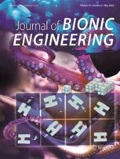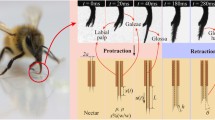Abstract
Many biological structures can perform highly-dexterous actions by using dynamic surfaces. To deal with the contradictive demands of high feeding efficiency and low energy expenditure during nectar feeding, the glossal surface of a honeybee undergoes shape changes, in which glossal hairs erect together with segment elongation in a drinking cycle. In this paper, we extracted a transmission link embedded in the glossa from postmortem examination and found that the compliance of the intersegmental membranes provides more possibilities for this highly kinematic synchronicity. According to the morphing phenomena of honeybee’s glossa, we proposed a compliant mechanism model to predict the deformation behavior of honeybee considering elastic properties of the glossal intersegmental membranes. The increase of membrane stiffness may improve the capacity of elastic potential energy transfer, but will still result in the increase of mass. An index is introduced to evaluate the contradiction for optimizing structural parameters. This work may arouse new prospects for conceptual design of micro-mechanical systems equipped with bio-inspired compliant mechanisms.
Similar content being viewed by others
References
Vincent J F V. Deployable structures in nature: Potential for biomimicking. Proceedings of the Institution of Mechanical Engineers, Part C: Journal of Mechanical Engineering Science, 2000, 214, 1–10.
Anderson C V. Off like a shot: Scaling of ballistic tongue projection reveals extremely high performance in small chameleons. Scientific Reports, 2016, 6, 18625.
Van Wassenbergh S, Strother J A, Flammang B E, Ferry-Graham L A, Aerts P. Extremely fast prey capture in pipefish is powered by elastic recoil. Journal of the Royal Society Interface, 2008, 5, 285–296.
Krenn H W, Plant J D, Szucsich N U. Mouthparts of flower-visiting insects. Arthropod Structure & Development, 2005, 34, 1–40.
Kim W, Bush J W M. Natural drinking strategies. Journal of Fluid Mechanics, 2012, 705, 7–25.
Lee S J, Kim B H, Lee J Y. Experimental study on the fluid mechanics of blood sucking in the proboscis of a female mosquito. Journal of Biomechanics, 2009, 42, 857–864.
Lehnert M S, Mulvane C P, Brothers A. Mouthpart separation does not impede butterfly feeding. Arthropod Structure & Development, 2014, 43, 97–102.
Kim W, Gilet T, Bush J W M. Optimal concentrations in nectar feeding. Proceedings of the National Academy of Sciences, 2011, 108, 16618–16621.
Paul J, Roces F. Fluid intake rates in ants correlate with their feeding habits. Journal of Insect Physiology, 2003, 49, 347–357.
Moulton D E, Lessinnes T, O’Keeffe S, Dorfmann L, Goriely A. The elastic secrets of the chameleon tongue. Proceedings of the Royal Society A: Mathematical Physical & Engineering Sciences, 2016, 472, 20160030.
Rico-Guevara A, Fan T H, Rubega M A. Hummingbird tongues are elastic micropumps. Proceedings of the Royal Society B: Biological Science, 2015, 282, 20151014.
Harper C J, Swartz S M, Brainerd E L. Specialized bat tongue is a hemodynamic nectar mop. Proceedings of the National Academy of Sciences, 2013, 110, 8852–8857.
Pernal S F, Currie R W. The influence of pollen quality on foraging behavior in honeybees (Apis mellifera L.). Behavioral Ecology and Sociobiology, 2001, 51, 53–68.
Wu J, Zhu R, Yan S, Yang Y. Erection pattern and section-wise wettability of honeybee glossal hairs in nectar feeding. Journal of Experimental Biology, 2015, 218, 664–667.
Zhao J, Wu J, Yan S. Erection mechanism of glossal hairs during honeybee feeding. Journal of Theoretical Biology, 2015, 386, 62–68.
Snodgrass R E. Anatomy of the Honey Bee, Cornell University Press, London, UK, 1984.
Zhu R, Lv H, Liu T, Yang Y, Wu J, Yan S. Feeding kinematics and nectar intake of the honey bee tongue. Journal of Insect Behavior, 2016, 29, 325–339.
Li C, Wu J, Yang Y, Zhu R, Shao Z. Drag reduction in the mouthpart of a honeybee facilitated by galea ridges for nectar-dipping strategy. Journal of Bionic Engineering, 2015, 12, 70–78.
Zhao C, Wu J, Yan S. Observations and temporal model of a honeybee’s hairy tongue in microfluid transport. Journal of Applied Physics, 2015, 118, 194701.
Roberts T J, Azizi E. Flexible mechanisms: the diverse roles of biological springs in vertebrate movement. Journal of Experimental Biology, 2011, 214, 353–361.
Chen Y, Wang X, Ren H, Yin H, Jia S. Hierarchical dragonfly wing: Microstructure-biomechanical behavior relations. Journal of Bionic Engineering, 2012, 9, 185–191.
Lichtwark G A, Bougoulias K, Wilson A M. Muscle fascicle and series elastic element length changes along the length of the human gastrocnemius during walking and running. Journal of Biomechanics, 2007, 40, 157–164.
Moulton D E, Lessinnes T, O’Keeffe S, Dorfmann L, Goriely A. The elastic secrets of the chameleon tongue. Proceedings of the Royal Society A: Mathematical Physical & Engineering Sciences, 2016, 472, 20160030.
Dickinson M H, Lighton J R B. Muscle efficiency and elastic potential energy storage in the flight motor of Drosophila. Science, 1995, 268, 87–90.
Wager J C, Challis J H. Elastic energy within the human plantar aponeurosis contributes to arch shortening during the push-off phase of running. Journal of Biomechanics, 2016, 49, 704–709.
Gronenberg W. Fast actions in small animals: Springs and click mechanisms. Journal of Comparative Physiology A, 1996, 178, 727–734.
Higham T E, Irschick D J. Springs, steroids, and slingshots: The roles of enhancers and constraints in animal movement. Journal of Comparative Physiology B, 2013, 183, 583–595.
Jensen B D, Howell L L, Salmon L G. Design of two-link, in-plane, bistable compliant micro-mechanisms. Journal of Mechanical Design, 1999, 121, 416–423.
Vincent J F V, Wegst U G K. Design and mechanical properties of insect cuticle. Arthropod Structure & Development, 2004, 33, 187–199.
Wegst U G K, Ashby M F. The mechanical efficiency of natural materials. Philosophical Magazine, 2004, 84, 2167–2186.
Appel E, Heepe L, Lin C P, Gorb S N. Ultrastructure of dragonfly wing veins: Composite structure of fibrous material supplemented by resilin. Journal of Anatomy, 2015, 227, 561–582.
Lobontiu N. Compliant Mechanisms: Design of Flexure Hinges, CRC press, Boca Raton, USA, 2002.
Author information
Authors and Affiliations
Corresponding authors
Rights and permissions
About this article
Cite this article
Yang, Y., Wu, J., Zhu, R. et al. The Honeybee’s Protrusible Glossa is a Compliant Mechanism. J Bionic Eng 14, 607–615 (2017). https://doi.org/10.1016/S1672-6529(16)60426-2
Published:
Issue Date:
DOI: https://doi.org/10.1016/S1672-6529(16)60426-2




